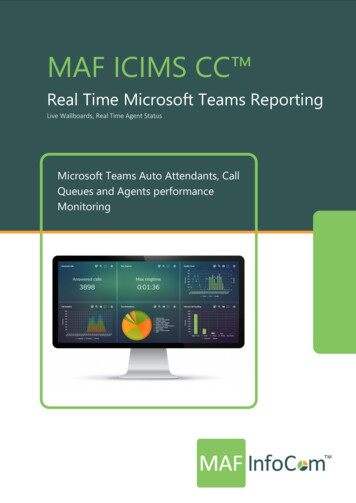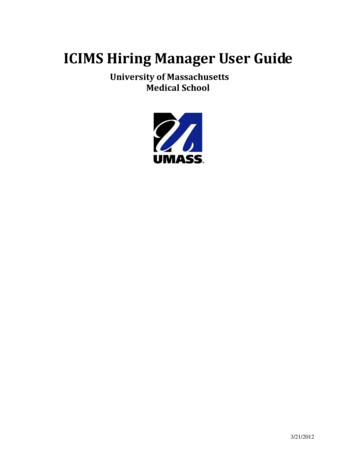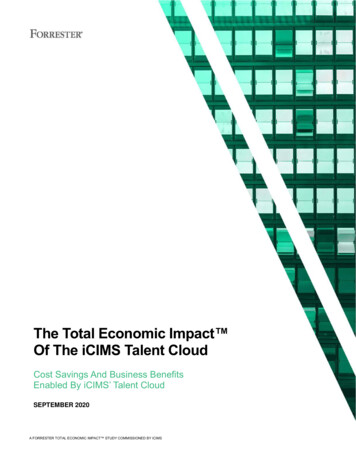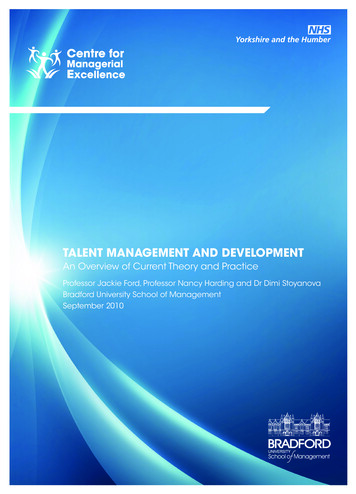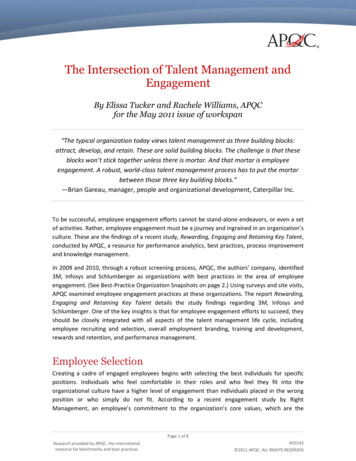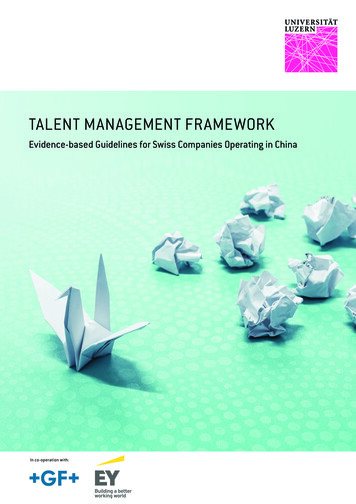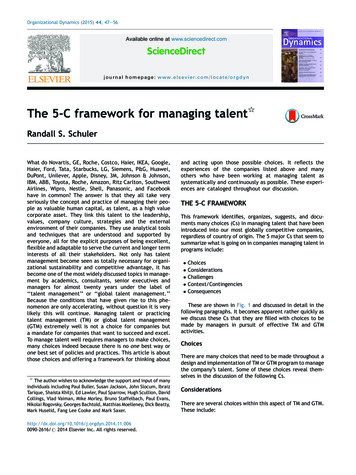
Transcription
The TalentPipelinePlaybookDraft the best talentfaster and more efficiently
The Definitive Guide to Building Your PipelineYour next MVP mayalready be in your lineupIf you need to build a transformativeworkforce then you need deepand varied talent pools andthere’s more to consider than justa candidate’s areas of interest,years of experience, job level etc.Modern pipelines are purpose-builtto include traditional, timely, andtactical talent pools.In this guide you’ll learn how to dig deeper intoyour roster of talent to rediscover candidates whoare already interested in working for you, some rightinside your company.2
The Definitive Guide to Building Your PipelineIt takes sifting through countless resumes to match the right person to the rightjob. You don’t have time for that. But what if there was a better way? What ifyou could organize your talent pools to segment them in various ways (likesegmentation to align to your high priority roles)? That way you could knowexactly where to match and rank top candidates, quickly.Strengthen the differentiation of your talent pools by implementing a robust CRMthat works with your team. That means sourcing new talent that may not havepreviously applied to your organization, or who may not have been considered anideal candidate in the past due to limited availability.As a TA/HR leader you have the opportunity (and the need) to revamp yourcandidate engagement strategies and truly make your tech work in ways that aremore intelligent, inclusive, and productive.Why a full roster makesa difference: Today the half-life of a learned skill is 5 years, even shorter for technical skills.In perspective, college degree “book learning” can be obsolete within a year ofgraduation – your talent pools need to be forward-looking.“Skill, re-skill and re-skill again: How to keep up with the future of work.” World Economic Forum. July 31, 2017. When your industry’s technologies evolve rapidly consider sourcing fromvocational, certification, badging, and apprenticeship environments for of-theminute skills (for example, 15% of one iCIMS developer team was sourced fromhacker school). Internal talent pools boost morale and decrease attrition from employees whofeel “overlooked.” Reskilling is more efficient and cost effective than re-hiringbecause it leverages employees that know your customer and your business.(Learn how one modern retailer, Room&Board, keeps employee turnover low).3
The Definitive Guide to Building Your PipelineUp on deck: How talent poolsstrengthen your hiring strategyInstead of operating in reaction mode, recruitment marketing software allowsyour recruiters to be proactive and stay ahead of talent needs. Building talentpools is an effective way to ensure a constant flow of candidates are available.(Learn more about recruitment marketing software).Winning plays to bolster your lineup:1. Assess strengths and weaknessesWhat you don’t know can hurt you when it comes to developing robust talentpipelines. Before building and organizing your talent pools ask yourself thefollowing questions to guide how you source: What critical positions and skills are needed at my company?What is my average time to fill?What is my company’s talent makeup?What is my company’s projected growth?How diverse are my sources and are they providing quality candidates?Do you consider non-traditional hires such as vocationally skilled, remotelylocated or contingent workers?4
The Definitive Guide to Building Your Pipeline2. Build fit-for-purpose talent poolsNow you’re ready to segment your talent pools based onyour current and future talent needs. Strong segmentedtalent pools ensure your company always has a pipelineof talented and qualified candidates to select from whena job becomes available. To get the most out of talentpools, recruiters must group candidates together basedon similarities and continue to communicate with theseconnections through personalized content.Example tags to organize your talent pools: Education levelWork experienceInterested role or departmentLocationSkills5
The Definitive Guide to Building Your Pipeline3. Engage with relevanceSending automated personalized, branded communicationsbased on your defined talent segments makes candidates morelikely to think of you when they are ready to apply to a job. Makethe application process even simpler by integrating text messagecapabilities. (Learn more about text recruiting channels here).Examples of marketing content that connectscandidates to your brand: Employment newsletters that include spotlighted jobs Automatic alerts for new job postings Employee spotlights including pictures or videos oftop performers Social media links to events, press releases, and need-to-knows Professional development programs at your organization Information on new products, expansion, growth, orsocial/civic activity6
The Definitive Guide to Building Your PipelineGrow your team organicallyTo have a sufficient pool of candidates from which you can draw,you will want to drive as much talent to your inbound hiring flowsas possible. One way to drive traffic to your brand is to incorporatean attention grabbing, graphical link that invites candidates tosign up to receive notifications from your company and join yourtalent pools. (The graphical link can be added to your career page,or if you leverage text recruiting, the link can be on posters orpromos). This type of link should appear consistently across yourrecruitment marketing materials, career pages, corporate socialmedia sites, and make it easier to apply via a text.70%OF EMPLOYERS SAYFINDING TALENTIS THEIR BIGGESTCHALLENGE7
The Definitive Guide to Building Your PipelineRecruit talent from around theworld with event managementThe best players can be anywhere, engage on their termsContinue to connect with candidates through virtual recruitingexperiences. Our chat-based online events provide employerswith a powerful and cost-effective way to reach job seekerswhen in-person recruiting events are not possible or practical.Expand your team with online and offline eventsTake charge of events with digital tools that let you worryless about logistics and focus more on relationship building.Manage events from start to finish with the ability to driveregistration, electronically receive resumes on site, and sendfollow up communications.Discover how Cedar Fairhosts and tracks hiringevents in their CRM to monitorevent ROI and improvestratetgic decisions.8
The Definitive Guide to Building Your PipelineCRM features that letyour lineup shineTo get the most out of your talent pools you tap into the powerof your CRM (Learn more about CRM features and benefits).Fill open positions faster by creating an engaged pipelineof candidatesTo build a quality talent pipeline, source from job seekers who havealready expressed interest in your company, previous silver-medalistcandidates, and applicants you’ve met at recruiting events or foundthrough networking platforms.Keep candidates informed and engaged in your talentpools until the right job becomes available withautomated campaignsRecruiters and recruitment marketers keep their talent pipeline activelyengaged with personalized, branded email campaigns on their side.Many CRMs include templates that make this process easier, butrecruiters should use campaign variables to keep candidates interestedin your organization and informed about topics relevant to their careeraspirations. Impactful campaigns include company updates, new jobopenings, images, links, videos, and prompt information.You can review candidate information within the CRM, invitecandidates to apply for open roles, and add candidates totalent pools for future engagement via email campaigns.9
The Definitive Guide to Building Your PipelineDraft the highest-quality talent with search,recommendations, and reportsQuickly prioritize your top prospects with filters for role typeand skills, and searches by keyword and location help tonarrow your talent pool to the top candidates, reducing time tosource and hire.The iCIMS CRM uses machine learning (ML) algorithmspowered by artificial intelligence (AI) to surface your mostqualified candidates instantly. AI and ML algorithms search yourCRM talent pool through use of keywords as broad as a jobdescription or as granular as education level.That means you can now sort 100% of resumes automaticallyand eliminate potential subjective bias from manual initialreviews. This frees up recruiters to focus on accelerating greatcandidates through the hiring process.Calculate talent spend with dataPull data that helps you determine where to spend yourrecruitment marketing dollars by following your candidate flowfrom your CRM and into your ATS. Organizations that reporton source effectiveness to reveal unique insights into howcandidates discover both your organization and your openroles. This insight can help your teams calculate what types oftalent pools are needed and where gaps exist. Source analyticsgive a transparent view of where candidates come from to aidin advertising and sourcing, helping you save money.Time out: Interested in learning more about recruitmentmarketing ROI? Check out The Definitive Guide toRecruitment Marketing ROI10
The Definitive Guide to Building Your PipelineEliminate red flags torecruit the best talentTo help you remove barriers that may be keeping talent pools shallow,we’ve compiled examples of each type of pool you should consider at yourcompany.Previously, organizations focused on a narrow array of talent pools (basedon qualifications, location, etc.) but remote work and the ability to reskill/educate employees are now an opportunity to appeal to deeper pools oftalent.Candidate Pools:External talent pools are high-level talent pools and cover broad topics,such as department or location. Since candidates will opt into these poolsthemselves, the topics should be more interest-based than qualificationbased, and they should encourage new candidates to connect with yourorganization. Traditional talent pools: Candidates typically self-select areas ofprofessional interest and are automatically entered into an aligned talentpool. Examples include:Position category or department: Enables candidates to express generalinterest in various divisions.Location: Useful for organizations who hire across multiple locations.Locations can be specific, such as a store or office location, or moregeneral, such as a state or region.Position level: Used to narrow down talent pools, it cuts down on timespent reviewing under-qualified or overqualified candidates for openroles.11
The Definitive Guide to Building Your Pipeline Timely talent pools: When sudden disruptions affect your sourcing plans andcurrent workforce, it’s important to address them head on. Challenges fromeconomic downturns, pandemics, or other unforeseen circumstances fall inthis category. Examples of talent pools to address workforce volatility include:Re-entry: Re-entry pools can be used for furloughed or laid off employeesto help keep them engaged and potentially bring back to the organizationwhen they time is right.Reengagement: Reengaged talent pools are great for those candidateswho were silver medalists for another position, accepted a job elsewherebut are not happy with the role, or for those who haven’t applied in awhileand want to throw their name back in the ring.New location: Talent pools for new locations are useful when offices mustclose or open in new locations that you have not previously sourced talent for.Remote work opportunities: These are essential as work becomes locationagnostic. Your goal is to find the best talent possible, and location need notbe a limiting factor.Gig workers: Talent and staff are among the most important resources thatkeep your business running, but you need your staffing teams to allocatethe right resources when and where they are needed most. Spreading thecosts and risks associated with FTE commitments across contingent staffcan get more done, with less.Seasonal workers: When your hiring spikes for seasonal rushes you need tohave a pool of seasonal workers who are ready and eager to work for yourbrand. Reduce time and cost to fill by dedicating pools for these seasonalspikes. (Learn how one of the world’s leading theme park operatorshires 47,000 seasonal workers annually).12
The Definitive Guide to Building Your Pipeline Tactical talent pools: For new initiatives and growthopportunities—like diversity and inclusion initiatives (sex, race,orientation, etc.) but also other hiring strategies like appealing tonew collar jobs (work level, experience, etc.). Examples of tacticaltalent pools include:Growth opportunity pools: Shift the hiring criteria fromcandidates’ formal education to jobs-to-be-done or teams tobe built—to meet your immediate and future business needs.Specialized pools for specific groups: Create talent pools forareas of the business lacking specific populations or areas thatcandidates and/or employees have expressed interest in. Forexample, growing women in tech.Diversity and inclusion pools: Ensure that everyone feelswelcome to join one of your organization’s talent pools.(Learn more about diversity in hiring in our blog withCareer.Place – an unbiased candidate screening solution).Secrets of the game:On the clock and need to draft talent faster?Check out assessments that eliminate bias andconsider both soft and hard skills.13
The Definitive Guide to Building Your PipelineEmployee pools:Internal talent pools for current employees help to addressskills gaps, turnover, employee satisfaction, career pathing,and professional growth opportunities. By generating internaltalent pools, you offer your employees the chance to growtheir careers (and their job satisfaction) while also improvingretention of your best talent. (Learn how one modern retailer,Room&Board, keeps employee turnover low).Talent pools based on job function or skill set help fine-tuneyour pipeline and make it easier to find candidates with relevantexperience for future open positions. Consider the types ofroles for which your organization recruits and create pools forthe different desired job titles or skills. Creating talent pools ofthis category cuts down on time spent reviewing candidatesfor open positions by pre-sorting them by the type of roles forwhich they may be a good fit. Examples: Project Management, Functional Training,Technical Support Tip: This category of talent pool can be combined with manyother segments, such as location, department, or role level,to create pools that match your organization’s recruitmentstrategy. Examples include Sales - Functional Training orTechnical Support - Management.14
The Definitive Guide to Building Your PipelineGear up with a playbookthat’s efficient, inclusive, andprepared for rapid changeThe job market can easily change due to shifts in the economyor unforeseen emergencies. With proper tools in place tomaintain an active and healthy talent pipeline regardless of whatmay come your way, you’re meeting hiring goals and avoidingrisk of slowing down the growth of your organization.Download The Game Plan for strong tactics on how to attractwinning talent, raise the bar on engagement, and unlock hiddentalent to advance key players.The Game Plan:HOW TO BUILD AWINNING TEAMLearn More4,000 clients 4M hires/year 300M candidatesEmail sales@icims.comCall 1.800.889.4422 or 44 {0} 118 9000 706Visit icims.com
the right resources when and where they are needed most. Spreading the costs and risks associated with FTE commitments across contingent staff can get more done, with less. Seasonal workers: When your hiring spikes for seasonal rushes you need to have a pool of seasonal workers who are ready and eager to work for your brand.
